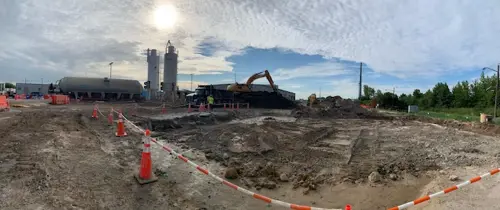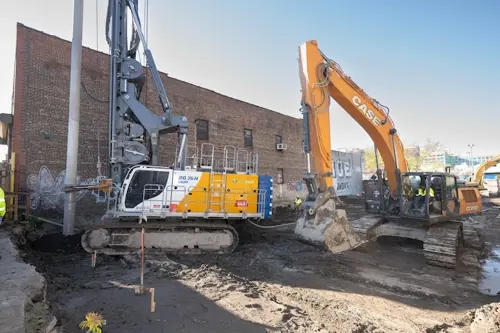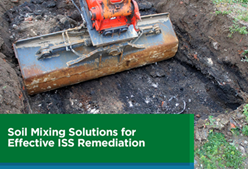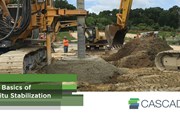The Basics of In Situ Stabilization
By: Deborah Shaffer (Schnell), P.E.
Conventional remediation options requiring excavation, removal, and disposal of impacted soils can be cost-prohibitive when a large quantity of material is involved. Costs for labor, equipment, disposal, and restoration increase with the volume of material to be addressed. Additionally, excavation dewatering and earth support can substantially increase remediation costs.
In situ stabilization (ISS), primarily associated with geotechnical stabilization of loose soils, can be an ideal alternative for many projects. ISS involves mixing reactive admixtures into the soil matrix. This can be a containment remediation strategy using amendments like cement and slag to fixate contaminants or a destructive approach using chemical amendments to oxidize or reduce contaminant concentrations. Since most environmental releases, impacts, and residual sources are within the range of mixing capabilities, ISS is suitable for a large percentage of environmental remediations, including both shallow and deep soil mixing alternatives. Cost benefits of treating in place increase directly with the volume of impacted soil.
In this blog post, I’ll explain how to assess site suitability, select the right mixing technology, and administer the correct treatment. For more information, watch our on-demand webinar, ISS/ISCO: What You Need to Know for Project Success.
Assessing Site Suitability

In the environmental sector, ISS works by reducing contaminant leachability, mobility, and matrix permeability. Contaminants can be chemically or physically altered but generally remain in place unless a destructive oxidation approach is used. Selecting the appropriate admixture/binder depends on site-specific factors:
Key Factors:
-
Contaminants of Concern (COCs): Identify the specific contaminants to be treated.
-
Concentration of COCs: Determine the levels of contaminants in the soil/sediment.
-
Geophysical Properties: Understand the soil/sediment characteristics.
-
Remedial Goals and Performance Criteria: Establish targets for permeability and compressive strength.
Suitable COCs for ISS:
-
Metals and Inorganics
-
Non-volatile Organics
-
Semi-volatile Organic Compounds: PAHs, PCBs, pesticides, dioxins, and furans.
-
Organic Compounds: Note that high levels of organics can affect cementitious reagents.
"Soft sediments" or un-lithified materials comprised of sands, silts, or clays are ideal for treatment.
Select Mixing Technology

ISS can be applied using various methods to mix binding reagents into contaminated media. The most common methods are:
Auger Mixing (Deep Soil Mixing - DSM)
-
Depth Capability: Achieves depths of 60 feet or greater, depending on lithology.
-
Consistency: Provides consistent mixing energy and repeatability.
Bucket Mixing
-
Equipment: Uses an excavator bucket or excavator-mounted mixing implements.
-
Depth Limitation: Limited to shallow depths (less than 30 feet).
-
Advantages: Preferable when foundation remnants or subsurface obstructions are present.
Executing the Treatment

Bench Scale and Pilot Testing
-
Treatability Testing: Essential for selecting and optimizing reagent components.
-
Performance Criteria: Establish criteria before implementation.
-
Pilot Testing: Plan and assess implementation compared to treatability results.
Construction Phase
-
Formulation Repetition: Ensure formulations developed during bench scale are achieved in the field.
-
Monitoring: Consistently monitor parameters like reagent/grout delivery rate, dosing, mixing speed, and time.
-
Sampling: Collect and test samples of treated media against performance criteria.
Gathering real-time data daily allows our team to make adaptive field decisions on mix ratios to guarantee project goals.
Is ISS For You?
ISS can be the perfect technology for meeting remedial goals when site conditions are right. Successful execution requires the right team of professionals, equipment, and proper planning and execution. Learn more about Cascade's ISS qualifications here.





